
They arrive from across the road, and around the world, descending upon a remote valley in the southern end of North Carolina's Blue Ridge Mountains. It is a pilgrimage into the past, where individuals search for a lost, treasured, lifestyle and art form. Their journey will reveal to them, a part of their soul that has either been forgotten or yet to be found...the essence of creativity.
All elements of the earth long to express themselves. This is evident in nature, the birth of Spring, the growth of Summer, the wonder of the leaf change in Autumn, as well as the solitude of Winter. The human soul longs to express itself, and that expression at its best is creative in nature.
Creativity is like an expectant mother. A seed of inspiration is planted, it then becomes nurtured within. The acceptance of its presence allows proper growth, taking shape and honing its form to the smallest detail within the inspired mind. The labor begins, and it is the physical exertion that brings about the birth of the inspiration.
We are all born with an innate creative instinct. Self expression excels in those who are aware of their creativity. Although there are some who are not aware of this inner resource. They might be afraid to delve into themselves, into the unknown. Worried that they may not have the creativity that they have seen in others, they don't open the door apprehensive over what they may find, wondering if it will be good enough. These people are locking away a treasure, a wealth of growth, accomplishment and self-discovery.
Only within the world of man do we find the concept of, "I can't." This statement is erroneous in the creative process. Creativity is our most basic instinct, it's how we came into being, and it begins with our very first breath of life.
We were created in this world, we are creative in the world.
We are creators of our world, we are creators in God's world.
Being artists ourselves, Mrs. Highlander and I have always known the joy and accomplishment of being creative. When we went to the John C. Campbell Folk School to meet with the publicity coordinator, talked with the instructors and the students and viewed the classes while collecting some photography, we were amazed at the quality of the works being produced by the students. Some of these students had never attempted that particular art before and their work was beautiful. It gave us a new respect for teachers. These teachers knew how to convey their talents to a novice in an amazingly short period of time.


 Our decision
to write a story on the school is due to our respect for the work they're
doing. They first introduce you to the most basic style of life by taking
you back to simpler times. In a state of unimposing atmosphere, the
instructors begin to ignite the fires of creativity. They have a method
of education, that leaves the student, a little more enlightened and
a lot more fulfilled. Their unique style of instruction and social camaraderie
quickens the spirit and awakens the creative flow.
Our decision
to write a story on the school is due to our respect for the work they're
doing. They first introduce you to the most basic style of life by taking
you back to simpler times. In a state of unimposing atmosphere, the
instructors begin to ignite the fires of creativity. They have a method
of education, that leaves the student, a little more enlightened and
a lot more fulfilled. Their unique style of instruction and social camaraderie
quickens the spirit and awakens the creative flow.
John C. Campbell Folk School, located on a 372-acre campus-farm, in Brasstown North Carolina, is a perfect melding of living history and the creative arts. Attending a class at the school is more than just a class in the arts, it is a trip back in time, when things were simpler and creativity was a way of life. The school was created as a unique institution that seeks to bring out the creative soul that lies within each of us.
John C. Campbell was born in Indiana and raised in Wisconsin, he studied education and theology in New England and was quick to feel the calling to do humanitarian work. Newly married, John and Olive, [born in Massachusetts] set out for the Southern Appalachian region to undertake a fact-finding mission on the social conditions of the mountains in 1908-1909. John interviewed the farmers about their agricultural practices, while Olive collected ancient ballads and studied the handicrafts of the mountain people. John and Olive felt that the quality of mountain life could be improved by education.
The Campbells were inspired by "folkehojskoles," or Danish folk schools. These "schools for life," helped to transform the Danish countryside into a vibrant, creative force in national life. The Campbells believed a similar school would benefit the rural south as an alternative form of education, offering intelligent young people an opportunity to remain in their homeland and still create a bright future.
Preserving the traditional and artistic lifestyle of the Appalachian people was the original vision of the Campbells. Unfortunately, John passed away in the year 1919, before their dream could become a reality.
Olive Campbell and her friend Marguerite Butler journeyed to Denmark, Sweden and other countries to study folk schools. Returning to the U.S., they were determined to start such a school in Appalachia. Imposing new ideas on the mountain folk would be no easy task, they both realized that in order to be successful in their endeavor, they needed to develop a genuine collaboration with the people of the region. After much effort. several locations were considered for the experimental school, Mrs. Butler explained the idea to Fred O. Scroggs, a local storekeeper of Brasstown NC. Several weeks later, she returned to the community, to a meeting of 200 people at the local church, the interest was obvious. The people of Cherokee and Clay Counties pledged labor, building materials and other support, and the Scroggs family gave 75 acres of land to start the school. Olive Dame Campbell, Marguerite Butler and the people of Brasstown, NC founded the John C. Campbell Folk School in 1925 and dedicated it to the dream and memory of John and a great tradition was born.
The goal of the Folk School is education in the performing arts, agriculture and crafts rooted in the traditions of Southern Appalachia and other cultures around the world. The school has an understanding that rural life is no longer isolated, it is a part of a global life that is increasingly interdependent.
The school supports a belief, that the individual expression and social interaction that is encouraged through music, crafts, gardening and dance are still meaningful to people today, regardless of where they live.



Materials, tools and motivations for these traditional arts have changed, but the satisfaction of developing skills in a noncompetitive, supportive environment are useful correctives to the hard-driven, often dehumanizing regimentation of much of today's world.
The campus is a unique setting in mountain style, the folk school now has 27 buildings and growing. The school has been designated a "Historical District" by the National Register of Historic Places. The campus has buildings in the Romantic European design, while some are of Appalachian styling, such as the original farm house.
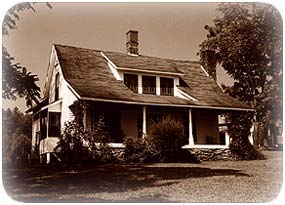
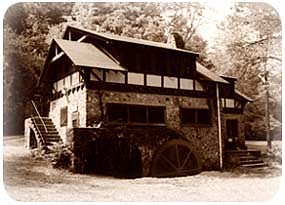
The campus has fully-equipped craft studios, a saw mill, blacksmith shop, meeting rooms, a covered outdoor dance pavilion, a nature trail, a vegetable garden, rustic lodgings, and a community room which has one of the best dance floors in America. There is also a craft shop for consumer sales, dining hall, history center, barns, trails, a campground, log cabins, and dorm quarters throughout the campus.
The John C. Campbell Folk School has a renowned reputation. The school offers an array of classes in folk art, from spinning to quilting, weaving to rug making, singing traditional folk songs to storytelling, woodcarving to furniture making, pottery to blacksmithing, calligraphy to printing, bead work to doll making, drawing to painting, instrument making and instrument playing lessons and so much more.

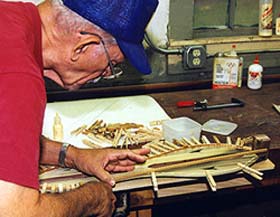 Classes last a week or weekend, depending
on the course. Many students use the school as a unique vacation retreat,
a vacation that sends you home refreshed and enthusiastic with a newly
learned creative art. Time spent at the school offers each student a
very special life experience. Students enjoy an atmosphere of natural
beauty and spirit that stresses process as much as product. Outside
the class, there are other opportunities to learn about the local history
of the Folk School and the lifestyle that it was created around. The
instructors of the school come from various backgrounds, skilled and
respected in their particular art. Most instructors arrive with the
students for a week or weekend of classes, while some are resident instructors.
Classes last a week or weekend, depending
on the course. Many students use the school as a unique vacation retreat,
a vacation that sends you home refreshed and enthusiastic with a newly
learned creative art. Time spent at the school offers each student a
very special life experience. Students enjoy an atmosphere of natural
beauty and spirit that stresses process as much as product. Outside
the class, there are other opportunities to learn about the local history
of the Folk School and the lifestyle that it was created around. The
instructors of the school come from various backgrounds, skilled and
respected in their particular art. Most instructors arrive with the
students for a week or weekend of classes, while some are resident instructors.
"The school's philosophy combines social interaction, through mealtimes and music, with the need to get back to a simpler time when the Appalachian people crafted their daily necessities and pleasures by hand, such as quilts and woodcarvings, blacksmithing tools and woven tapestries."
 The
director of John C. Campbell Folk School, Jan Davidson states, "people
need to make things with their own hands, not just to learn a skill,
but to satisfy their soul."
The
director of John C. Campbell Folk School, Jan Davidson states, "people
need to make things with their own hands, not just to learn a skill,
but to satisfy their soul."
Part of the old Danish idea of the folk school was that instructors and students worked together sharing their ideas, needs and abilities. Individual development and creativity blossomed in a supportive social interaction. Today, the Folk School is still anchored in humanitarian idealism, still believes in creating community, and still hopes to help people find the best part of themselves.
 Students and
many instructors arrive at the school on Sunday, between 3-5:30 p.m.
Monday morning begins as all Folk School mornings do, with a walk through
the woods, to put you in touch with the natural self. Morning Song begins
each new day with music, singing and history. From there, it's off to
class for everyone. Three meals a day are served in the Olive D. Campbell
Dining Hall. Evenings are focused on social activities including...music,
storytelling and demonstrations. Friday is the culmination of the week,
the evening includes a student exhibition, where students can proudly
share the results of their creative work, followed by an evening concert
celebration.
Students and
many instructors arrive at the school on Sunday, between 3-5:30 p.m.
Monday morning begins as all Folk School mornings do, with a walk through
the woods, to put you in touch with the natural self. Morning Song begins
each new day with music, singing and history. From there, it's off to
class for everyone. Three meals a day are served in the Olive D. Campbell
Dining Hall. Evenings are focused on social activities including...music,
storytelling and demonstrations. Friday is the culmination of the week,
the evening includes a student exhibition, where students can proudly
share the results of their creative work, followed by an evening concert
celebration.
A student arrives open and longing, they leave relaxed, excited, feeling accomplished and very satisfied.
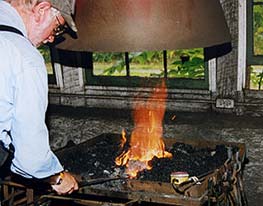
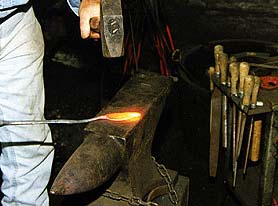
The folks at the Blue Ridge Highlander just happened to stumble across the school during a sightseeing and photo taking excursion three years ago. We were captivated by the setting of this unique campus with all its turn of the century ambience. You'll find the peace and tranquility of the school is the genuine article, the folks, students and instructors are friendly and happy to assist.
Since the beginning, the Folk School has sought to bring people toward two kinds of development: inner growth as creative, thoughtful individuals, and social development as tolerant, caring members of the community. The John C. Campbell Folk School is not just a school geared towards the teaching of craft making...it's an experience in living.
![]()
Sign
up for the Blue Ridge Highlander Newsletter, Messages from the Mountains
to find out first about our new feature stories, road trips and special offers
Your e-mail addresses will not be sold or given away to anyone.
Privacy
Policy
Interested in your business being on the Highlander, click here...
Let our visitors tell you about the Highlander...
Click the feathers to go to the Highlander site
map...

